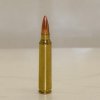Lone_Gunman
Member
I am working on resizing a large amount of LC 5.56mm brass. This was shot out of both M4s and SAW rifles.
I have used both a standard Lee 223 sizing die, as well as RCBS small base die. I am using a Lee shell holder for both.
I am resizing on a single stage press. I screw the die in until it hits the shell holder, then screw in half a turn more so I can over cam a little.
After I resize the case, I drop it into a Lyman case gauge. About 20% of the time, no matter which dies I am using, I get a case that sticks out of the case gauge by a tiny amount, I would say 1 millimeter. Sometimes if I push just a little, the case will go ahead and seat flush in the case gauge. I am rejecting all brass that will not seat flush into the Lyman case gauge.
Also, I have noticed that about 10% of the cases don't want to slide easily into the shellholder on the press. I have tried this with two different Lee shellholders, and get the same problem. I cannot see a defect in the case head that would explain why they won't slide easily into the shellholder. The brass that has a hard time sliding into the shellholder easily is the brass most likely not to fit into the case gauge after resizing.
Questions:
Why won't all the brass easily slip inot the shell holder?
Why does some of the brass not get sized small enough to drop into the Lyman case gauge?
Is this related to the type of weapon the case was originally fired in (ie, a machine gun with a looser chamber)?
If the resized case does not fit easily into the Lyman case gauge, should I reject it? Is there some way to still salvage it?
Should I also discard the brass that will fit into the case gauge with a little push?
Do I need to use a RCBS shell holder with the RCBS small base die sizer? Or is the Lee shell holder OK to use with it also? Will a RCBS shellholder fit into the ram of my Lee single stage press?
I have used both a standard Lee 223 sizing die, as well as RCBS small base die. I am using a Lee shell holder for both.
I am resizing on a single stage press. I screw the die in until it hits the shell holder, then screw in half a turn more so I can over cam a little.
After I resize the case, I drop it into a Lyman case gauge. About 20% of the time, no matter which dies I am using, I get a case that sticks out of the case gauge by a tiny amount, I would say 1 millimeter. Sometimes if I push just a little, the case will go ahead and seat flush in the case gauge. I am rejecting all brass that will not seat flush into the Lyman case gauge.
Also, I have noticed that about 10% of the cases don't want to slide easily into the shellholder on the press. I have tried this with two different Lee shellholders, and get the same problem. I cannot see a defect in the case head that would explain why they won't slide easily into the shellholder. The brass that has a hard time sliding into the shellholder easily is the brass most likely not to fit into the case gauge after resizing.
Questions:
Why won't all the brass easily slip inot the shell holder?
Why does some of the brass not get sized small enough to drop into the Lyman case gauge?
Is this related to the type of weapon the case was originally fired in (ie, a machine gun with a looser chamber)?
If the resized case does not fit easily into the Lyman case gauge, should I reject it? Is there some way to still salvage it?
Should I also discard the brass that will fit into the case gauge with a little push?
Do I need to use a RCBS shell holder with the RCBS small base die sizer? Or is the Lee shell holder OK to use with it also? Will a RCBS shellholder fit into the ram of my Lee single stage press?




